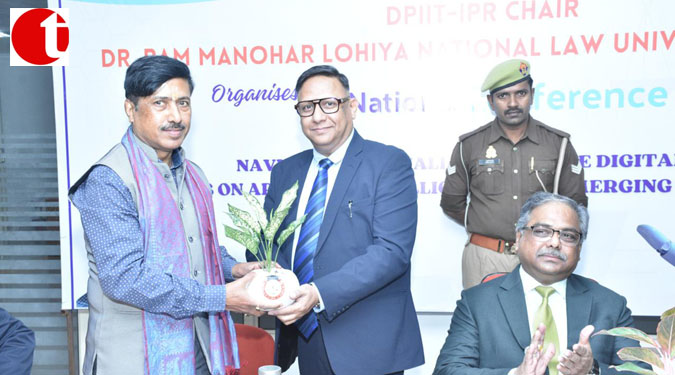TIL Desk Lucknow :👉 Welcome Note by DPIIT IPR Chair Professor (Prof. Manish Singh): The National Conference on “Navigating IP Challenges in the Digital Age: Focus on Artificial Intelligence and Emerging Technologies,” organized by the DPIIT-IPR Chair at Dr. Ram Manohar Lohiya National Law University, Lucknow, is set to be an insightful event fostering collaboration and dialogue.
In his welcome address, Mr. Manish, DPIIT IPR Chair Professor, emphasized AI’s transformative impact on global economies and the necessity for rigorous intellectual property frameworks to address the dual-edged nature of this technological evolution. While AI has moved beyond the realm of fiction into practical, far-reaching applications—from creating art and literature to advancing pharmaceutical research—it has raised significant concerns regarding potential misuse and ethical challenges.
This conference is a crucial platform, uniting policymakers, legal experts, scholars, and innovators to discuss these pressing issues. Mr. Manish encouraged active participation, highlighting the importance of collaborative efforts in shaping policies that safeguard innovation while mitigating risks. He underscored the long-term impact of these joint efforts on the future trajectory of AI and emerging technologies.
Address by the Keynote Speaker (Mr. Saurabh Tiwari): Good morning, everyone. I warmly welcome all the attendees, including the esteemed faculty, distinguished guests, and participants. It is a privilege to address such an insightful gathering today.While artificial intelligence (AI) is not entirely new, its accessibility to the general public has significantly changed the landscape. The pervasive nature of AI makes it crucial to examine how far we have come and where we are headed. From early developments that trace back to pioneers like Thomas Edison to Harold Cohen’s generative artwork, we see how AI has evolved from experimental creations to significant technological drivers in today’s world.
In the current era, technology like NFTs has emerged, representing digital assets that cannot be physically touched but hold value. Governments and institutions now wield advanced tools to navigate this landscape, and with them come challenges and legal disputes, such as the well-known “monkey selfie” case where a British photographer’s work was ruled as part of the public domain. Courts have begun to explore whether non-human creators can hold copyright, setting important precedents for future cases.
AI models are trained on extensive datasets, which raises significant questions about the inclusion of copyrighted materials. This introduces the issue of private ordering, which began in the 1990s and involved self-regulating algorithms. The proposed AI Act, which has taken nearly three years to shape, aims to address these disparities, yet inequities persist.
Consider the case of DABUS (Device for the Autonomous Bootstrapping of Unified Sentience), which highlights a shift from IP being solely human-centric to recognizing machine contributions. Stephen Thaler, who asserted that DABUS should be recognized as an inventor, underscores how AI challenges the boundaries of intellectual property. Similarly, artist Hollie Mengert’s work was reproduced by someone who used AI to generate art in a matter of minutes—art that took her years to develop. However, she refrained from pursuing legal action due to the high costs and lengthy litigation process.
Instances like these reveal that AI-generated content blurs the line between creator and creation, leading to complex legal questions about ownership. In one personal example, the content I created was reposted without my consent, demonstrating how challenging it can be to protect digital work. Legislative frameworks like GDPR and DMCA provide some protection but often require substantial financial and time investments to enforce.
Virtual property in gaming and digital environments brings further complications. When creators generate virtual objects or assets, copyright issues emerge, especially in the context of e-sports and online content. These situations highlight the necessity for ethical guidelines and legislative measures to protect creators and consumers.
In conclusion, as AI redefines creativity and innovation, laws must adapt to these technological advancements. Blockchain and other technologies are already used in diverse contexts, including adult content regulation, showcasing how complex and varied these challenges are. Legislative steps, supported by ethics as guardrails, must evolve to provide comprehensive protection and clarity in this ever-changing digital age.
Thank you.
Address by the Guest of Honour (Dr. Raghavender GR): Good morning, everyone. It is a pleasure to be here today and share insights on this critical juncture where technology, policy, and law intersect. I want to emphasize how India, through initiatives like NITI Aayog, has been at the forefront of transformative technological change. The advancements we see today, including developing machine learning models and AI systems, have been made possible due to concerted efforts that bridge innovation and policy.
The technological landscape has three approaches or “schools of thought”: revolutionary, evolutionary, and regulatory. These schools define how we perceive and integrate advancements into our society. The very essence of human progress can be traced back to revolutionary thinking, where boundaries are pushed and new paradigms are established.
He mentioned the significant progress in natural language processing (NLP) models shaping our interaction with technology, backed by sophisticated deep learning algorithms. Dr. Raghavender illustrated the profound nature of how these models mirror human communication.
However, he acknowledged that while the progress is exciting, there are also frustrations and challenges. As he put it, “If you don’t allow me…” encapsulates the barriers that innovators and thinkers often face when trying to push the envelope. In a moment of frustration, he reiterated a statement expressing that outdated structures should not stifle innovation.
In a light-hearted note, Dr. Raghavender referenced Elon Musk and how his friend winning an election was a positive for specific technological ambitions. Yet, the key takeaway was that India’s efforts to foster an innovative ecosystem have led to a significant shift in global perspectives. As he humorously remarked, “Copyright ka toh dukan band ho gaya,” signaling that traditional business models, particularly in the copyright realm, are being upended in favor of more open and adaptable systems.
Throughout his address, Dr. Raghavender spoke passionately in favor of India’s resilience and progress, emphasizing the role of robust policy frameworks and the need for ongoing development to align with global technological trends.
Address by the Chief Guest ( Justice Syed Qamar Hasan Rizvi): Good afternoon to everyone present, including the team, faculty members, and distinguished guests. It is an honor to be here today, especially in a company with such dynamic leaders. While AI is not my primary area of expertise, I appreciate the opportunity to learn and share insights in this evolving field.
Artificial Intelligence has transitioned from a concept of fiction to a powerful force reshaping industries and societies. AI’s ability to generate human-like content—from music and art to technical innovations—challenges our existing legal frameworks, especially intellectual property (IP) laws. Questions arise: Who owns AI-generated creations? Can AI be considered an inventor or author? These are not just legal questions but philosophical ones, touching on creativity and ownership.
As AI’s role in branding, engineering, and drug discovery grows, so do the complexities surrounding copyright, patent, and trademark laws. If an AI-created design resembles a protected brand, who is liable? Furthermore, AI’s reliance on massive data sets raises concerns about privacy and ethical use.
In virtual environments, issues of ownership and rights become even more pronounced. Can digital creations be copyrighted or trademarked? These are critical areas for discussion.
In conclusion, addressing these challenges requires collaborative efforts among legal experts, policymakers, technologists, and creators. We must update our frameworks to balance IP protection with innovation, ensuring fairness and progress in the digital age.
Address by the Vice Chancellor: Good afternoon, distinguished guests, colleagues, and dear students. Addressing such a gathering filled with bright minds and insightful perspectives is an honor. Like Justice Rizvi, I am not an expert in the field we discuss today. However, as a typical law student and an observer of the evolving landscape, I would like to share a few thoughts on technological progress’s significant challenges and opportunities, particularly in artificial intelligence (AI) and its legal implications.
Over the years, we have witnessed a transformation in the life processes, which has occurred faster than ever before. The phenomenon of “future shock” aptly describes this—when rapid technological changes lead to a situation where society struggles to keep up. In such instances, the legal field, often bound by tradition and the slow pace of legislative processes, tends to follow these developments instead of leading them.
This scenario is typical in which technological evolution and legal adaptation move simultaneously. The law attempts to follow as systems evolve and changes occur in the socio-economic environment. However, the gap between rapid technological advancements and the slow response of the legal framework can create significant regulatory challenges.
For instance, when emerging technologies such as artificial general intelligence (AGI) come into play, they create a dual potential. On one hand, AGI represents groundbreaking opportunities for innovation and progress. On the other hand, it poses a profound challenge for regulators and lawmakers who must catch up to manage its implications effectively. This gap can result in a landscape where ethical and social considerations risk being overlooked without integrity and foresight.
The role of courts in addressing these challenges cannot be understated. Courts often invent new expressions and adapt constitutional modalities to interpret situations that the existing legal framework may not adequately cover. This adaptive process is crucial, but it also highlights the importance of aligning legislative and judicial responses with the pace of technological change.
When AI systems are integrated into areas like information technology, India has demonstrated its edge over other nations. However, this success also brings forth contradictions and emerging regulatory gaps. These gaps can only be bridged through human-centered approaches incorporating ethical and social morality as guiding principles. The values that uphold our legal system—integrity, justice, and fairness—must continue to shape how we respond to technological advancements.
In conclusion, gatherings like this provide an excellent platform for brainstorming, exchanging ideas, and generating innovative solutions. Under the guidance of experts and scholars, we can navigate these emerging contradictions and turn them into opportunities for growth. I extend my heartfelt thanks to all our esteemed guests for their valuable contributions and to all of you for participating and enriching this conversation. Thank you for listening patiently. Your engagement is what makes discussions like these genuinely impactful.
Valedictory Ceremony Professor Subhash Chandra Roy: Good evening, esteemed colleagues and participants, I am honored to address you today as we reflect on the challenges and opportunities arising from artificial intelligence (AI) and emerging technologies in the realm of intellectual property (IP). The rise of AI-generated content raises important questions about ownership, attribution, and the role of legal frameworks in protecting such content. We must consider whether AI-generated works should be attributed to the AI system, its programmer, or the user of the technology.
The digital era has highlighted the need to reassess our IP laws, especially in the context of rapid technological advancements and the growing reliance on digital platforms, as seen during the COVID-19 pandemic. It is essential to establish clear, consistent guidelines for protecting digital assets and to develop uniform global standards to address cross-border enforcement inconsistencies.
In conclusion, I extend my gratitude to all contributors for their insightful discussions, which mark the beginning of an ongoing dialogue to shape the future of IP laws in the digital age.
Thank you.
Dr. Indra Dwivedy: She focused on the evolving challenges of intellectual property (IP) law in light of emerging technologies such as artificial intelligence (AI) and biotechnology. Drawing from her extensive experience with the Council of Scientific and Industrial Research (CSIR), Dr. Dwivedy discussed the significant reforms in Indian IP law, particularly post-1995 when India aligned its laws with international standards following its WTO membership.
She highlighted the difficulties in patenting AI-related innovations, noting that, initially, AI-driven inventions were poorly understood, which complicated the patent application process. Dr. Dwivedy referenced the Microsoft vs. Assistant Controller case as a key moment in establishing clarity for AI patents. She emphasized the need for regular updates to patent guidelines, particularly for AI and other advanced technologies, which have outpaced the current frameworks introduced in 2017.
The importance of an interdisciplinary approach between legal professionals, scientists, and technologists to address these challenges effectively was highlighted. She called for continuous collaboration to ensure that legal systems can adapt to technological advancements while protecting intellectual property.



